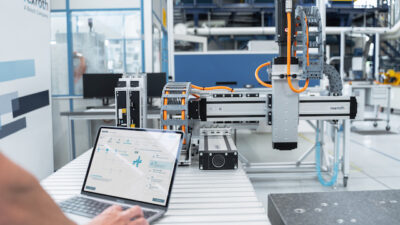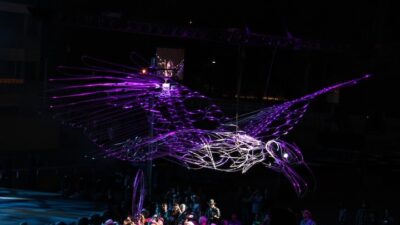Too many standards or not enough, that's the question? Whether or not you include de facto industry standards and communication standards as part of motion control will determine that answer.
A condensed version of this article appears in the supplement that ran with the February 2003 issues of Control Engineering and Design News.
Too many standards or not enough, that’s the question? Whether or not you include de facto industry standards and communication standards as part of motion control will determine that answer.
Standards and application guidance can come from numerous sources. While communication methods have their place in motion control, they’re just as vital in other sectors of automation and control. More at the core of motion control are evolving standards based on overall system architectures-whether centralized or distributed. Lately, distributed architecture has drawn most attention, due to advances in digital technology that allow local embedding of intelligence and other benefits.
Top-down approaches
PLCopen (Zaltbommel, Netherlands)-one of several vendor-independent and product-independent organizations involved in standards-has expanded its scope to motion control. More known for driving a standard on PLC programming languages (IEC 61131-3), the new activity at PLCopen is specification of ”Function Blocks for Motion Control” released as version 1.0 in November 2001.
These function blocks work like flowcharts to help develop control logic. PLCopen’s specification includes a library of function blocks covering single-axis motion, as well as coordinated, multi-axis motion control. Based on IEC 61131-3, the method seeks to standardize interfaces among different motion control approaches and promote greater reuse of application software. As an aside, engineers also program servo motion systems using languages specified within the IEC 61131 standard, for example, ladder logic, structured text, and sequential function chart.
Managing director of PLCopen Eelco van der Wal notes support for the Motion Blocks specification in the form of increased number of certified product suppliers, users, and OEMs. Says, Mr. van der Wal, ”I am pleased to see that this specification is [being] very well accepted by both end-users and original-equipment manufacturers (OEMs). It shows clearly that the merger of logic control and motion control into one platform generates a substantial user benefit.” He looks forward to endorsement from OMAC and European user organizations. ”First applications based on this specification have hit the market,” adds Mr. van der Wal.
This refers to software control products from Siemens and Beckhoff that were certified to requirements of PLCopen’s specs, and shown at Hannover Fair 2002 in Germany. Certified products can use the appropriate PLCopen logo.
PLCopen’s Task Force Motion Control continues its work to widen the specification’s basic functionality (Part 1) by specifying extended functionality in Part 2 and user guidelines in Part 3. Only Part 1 is available now. The intent is to enable ”user-derived function blocks” by having the highest level technology functions in Part 3, with all supporting functionality included in part 2. The task force has identified 17 Function Blocks for inclusion in the spec, among them are interpolation, registration-and on technology level-flying sheer, web cutting, rotating cutter, programmable cam switch, and dynamic synchronization.
This diagram illustrates the basics of PLCopen’s ”Function Blocks for Motion Control.”
Open Modular Architecture Controls (OMAC) is another initiative with a top-down approach to standardization. Founded in 1997, OMAC actually is an association of end-users, OEMs, vendors, and system integrators with motion control among its tasks. Ongoing adoption of electronic servo controls in packaging machinery, and related package printing and converting equipment, has drawn current standards interest. One of OMAC’s 10 user-directed working groups-Packaging Workgroup-is pursuing “a common approach” to develop future equipment of this type.
Among projects of the Packaging Workgroup is the evaluation of PLCopen’s motion control specification (Function Blocks) through pilot tests at manufacturing plants. Project goals are to verify “savings attributable to these specs in programming, maintenance, and reuse of code,” according to OMAC. Another OMAC working group, API WG, has the task to develop an application interface for servo-drive control of industrial machinery. The API defines control modules and their interface specifications to permit their full interoperability. Application testing of the API on servo-driven packaging machines begins soon at NIST (National Institute of Standards and Technology, Gaithersburg, MD).
Servos, other motor types, electric drives
Motors and drives receive coverage under various standards. For example, NEMA Standard Publication ICS 16-2001, ”Industrial Control and Systems, Motion/Position Control Motors, Controls and Feedback Devices,” is a recent, extensive look at these three ”interconnected components”of a motion control system. Issued by the National Electrical Manufacturers Association (Rosslyn, VA), NEMA ICS 16 addresses requirements of such “control motors” categories as all servo motors; all stepping motors; brush-type servo; and brushless servo. Also covered are controls and position/velocity feedback devices (rotary encoders and resolvers). A comprehensive section on definitions and terms adds to the publication’s usefulness.
A further resource guide to motion-control technology, products, and applications is NEMA’s ”Programmable Motion Control Handbook.” The 100-plus page publication contains applications, vendor references, standards, and a glossary.
Still another NEMA source, ”Application Guide for AC Adjustable Speed Drive Systems,” aids the selection of these ”systems” rated up to 600 volts, defined as three-phase induction motors; voltage-source, pulse-width modulated (PWM) adjustable-frequency controls; and associated components. The guide addresses common issues to consider when selecting drive system components and when installing or applying an entire drive system.
The International Electrotechnical Commission (IEC, Geneva, Switzerland) is a premiere source of standards. Among IEC offerings in the motion-control sector are standards for adjustable-speed electrical power drive systems and various electric motors. For example, IEC 61800-2 provides rating specifications for low-voltage, adjustable-frequency ac power drive systems up to 1,000-V input.
Communications’ role
Virtually all communication standards used in motion control originated from other applications. One exception is SERCOS (SErial Realtime COmmunication System), which specifies an interface among motion controllers, digital drives, and other system components. SERCOS is based on fiber-optic ring architecture, and now offers message transmission rates up to 16 Mbps. Supporting organizations for this protocol are Interests Group Sercos (Stuttgart, Germany) and, in North America, SERCOS N.A. (Bloomingdale, IL). www.sercos.com www.secos.org .
SERCOS claims sole international recognition in the motion-control sector through its designation as IEC Std. 61491. Motion profiles specific to packaging machinery also are under development by SERCOS. However, being a standard specific to motion control can also have a downside. Some critics say that SERCOS complicates the adding of vision and data-acquisition systems, which increasingly are integrated with motion control.
IEEE Std. 1394, ”High-Speed Serial Bus” (FireWire), developed by the Microcomputer Standards Committee of the Institute of Electrical and Electronics Engineers (IEEE, New York, N.Y.) has a following in motion control and servo systems, although it was developed for computer and consumer electronics. A major benefit of this standard is high-speed data transmission with rates up to 400 Mbps. FireWire is said to be compatible with vision systems. Also note that while the basic protocol of FireWire is open, specific implementations by different vendors are not interchangeable.
Ethernet, with origins in the office-equipment world (based on IEEE 802.3 standards family), is another communication method applied in some motion systems. Ethernet comes in several flavors with data rates up to 100 Mbps, but IEEE has recently approved a 10-Gbps Ethernet version. Here again, implementations in hardware vary from one manufacturer to another. One recent version, developed for distributed and fast, synchronized motion-control applications by B&R (Bernecker + Rainer Industrie-Elektronik) of Eggelsberg, Austria (U.S. location is Roswell, GA), claims network jitter is under 1
CAN in Automation (CiA, Erlangen, Germany) promotes the marketing of CAN (Control Area Network) serial bus, born in the automotive world. The non-profit CiA association develops and supports various CAN-based higher layer protocols. It also administers the CANopen specification, which serves as a simplifying tool to allow direct peer-to-peer data exchange among network nodes.
Significant to this arena are two CANopen Device Profiles-Drives and Motion Control (DS 402) and Encoders (DS 406). Available through CiA, these device profiles define basic functions and parameters to help standardize motion system implementation. Profile DS 402 specifies various operating modes, such as profile position, interpolated position, profile velocity, and profile torque. It also covers coordinated multi-axis motion, allows for manufacturer-specific objects, and includes an object dictionary.
Other communication methods are applied in motion control, as well, promoted by industry groups using de facto or proprietary ”standards.” And the quest for still more capable communications buses continues. New alliances among technology supplier companies periodically form to promote such ”industry standards.”
Selected Standards Sources for Motion Control
APS
www.aps.anl.gov
CiA
www.can-cia.com/cia
IEC
www.iec.ch
IEEE
www.standards.ieee.org/micro
SERCOS N.A
www.sercos.com
NEMA
www.nema.org
NIST
www.isd.mel.nist.gov
OMAC
www.omac.org
PLCopen
www.plcopen.org
In some cases, downloading of publications is free.
Other standardization
Government agencies and industry initiatives likewise produce standards and add to related knowledge. A publication of NIST’s Intelligent Systems Division, Manufacturing Engineering Lab, simply entitled ”Motion Control Standards,” provides an excellent overview of the standards ”landscape.” It includes a summary of the numerous communication standards in use. Click here for more information.
A set of motion standards from the Advanced Photon Source (APS) research facility of Argonne National Laboratory (near Chicago, IL) is worthy to note. An in-house development, APS standards provide a consistent interface to motors-typically of the stepper variety-used by collaborative teams of scientists working at stations located all around an approximately 1-km circumference ring that produces high-energy x-rays for research. ”APS standards” are intended to allow scientists to move their equipment (and motors) from one experiment area to another; also to swap similar components, without special cables, connectors, or lengthy setups.
”Experiments are done in locked, shielded enclosures, requiring a fully automated, remotely operated motion control and data-acquisition system for each setup. The idea was that scientists in one experimental area should be able to take a piece of equipment and connect it in a different experimental area without special cables, connectors, etc.,” says Kurt Goetze of the APS Beamline Controls and Data Acquisition Group, at Argonne National Laboratory. ”Results so far have been positive.”
Jayson Wilkinson, motion control product manager at National Instruments (NI, Austin, TX) notes the difficulty in adopting one or a few standards, given the many supplier companies and the wide variety of applications. ”It would be difficult to create a connectivity and communication standard that would meet all of their needs,” he says. Users have a further standards ”challenge” when they wish to combine best-of-class products from different manufacturers, explains Mr. Wilkinson. They need to verify ”if the products are indeed compatible and then actually determine how to connect them.” One way that NI addresses these issues is through its Motion Partner Program that enlists leading manufacturers of connected equipment to define connectivity between NI motion controllers and their products. Other motion technology companies also take a partnering route, often forming a group with similar interests.
Unification prospects
What’s ahead for motion control standards? Recognized, vendor-independent standards are evolving, albeit slowly. Complex, underlying technology issues, as well as the desire of suppliers to protect their investments, affect the pace of progress.
Also missing is a unifying body to integrate various separate standards developments-and further initiatives yet to come-into a cohesive whole for greater benefit of users.



